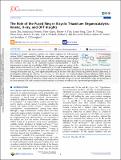Files in this item
The role of the fused ring in bicyclic triazolium organocatalysts : kinetic, X-ray and DFT insights
Item metadata
| dc.contributor.author | Zhu, Jiayun | |
| dc.contributor.author | Moreno, Immaculada | |
| dc.contributor.author | Quinn, Peter | |
| dc.contributor.author | Yufit, Dmitry S. | |
| dc.contributor.author | Song, Lijuan | |
| dc.contributor.author | Young, Claire M. | |
| dc.contributor.author | Duan, Zhuan | |
| dc.contributor.author | Tyler, Andrew R. | |
| dc.contributor.author | Waddell, Paul G. | |
| dc.contributor.author | Hall, Michael J. | |
| dc.contributor.author | Probert, Michael R. | |
| dc.contributor.author | Smith, Andrew D. | |
| dc.contributor.author | O'Donoghue, AnnMarie C. | |
| dc.date.accessioned | 2022-03-02T10:30:03Z | |
| dc.date.available | 2022-03-02T10:30:03Z | |
| dc.date.issued | 2022-03-18 | |
| dc.identifier | 277902903 | |
| dc.identifier | bd5d7753-0614-4edb-9a76-8c4c182a7a7b | |
| dc.identifier | 85125960046 | |
| dc.identifier | 000776255900032 | |
| dc.identifier.citation | Zhu , J , Moreno , I , Quinn , P , Yufit , D S , Song , L , Young , C M , Duan , Z , Tyler , A R , Waddell , P G , Hall , M J , Probert , M R , Smith , A D & O'Donoghue , A C 2022 , ' The role of the fused ring in bicyclic triazolium organocatalysts : kinetic, X-ray and DFT insights ' , The Journal of Organic Chemistry , vol. 87 , no. 6 , pp. 4241-4253 . https://doi.org/10.1021/acs.joc.1c03073 | en |
| dc.identifier.issn | 0022-3263 | |
| dc.identifier.other | ORCID: /0000-0002-2104-7313/work/117211348 | |
| dc.identifier.uri | https://hdl.handle.net/10023/24973 | |
| dc.description | Authors thank the EPSRC (JZ and CMY, EP/S020713/1; PQ, EP/M506321/1), ZD (CSC St Andrews PhD studentship), Universidad de Castilla-La Mancha and the European Regional Development Fund (IM) and the BBSRC (MJH, MRP and ART, BB/L013754/1) for funding. | en |
| dc.description.abstract | Bicyclictriazolium scaffolds are widely employed in N-heterocycliccarbene (NHC) organocatalysis. Whilst the incorporation of a fused ring wasinitially for synthetic utility in accessing chiral, modular triazolyl scaffolds,recent results highlight the potential for impact upon reaction outcome with underpinningorigins unclear. The common first stepto all triazolium-catalyzed transformations is C(3)-H deprotonation to form thetriazolylidene NHC. Herein, we report ananalysis of the impact of size of the fused (5-, 6- and 7-membered, n=1, 2 and3 respectively) ring on the C(3) proton transfer reactions of a series of bicyclictriazolium salts. Rate constants for the deuteroxide-catalyzed C(3)-H/D-exchangeof triazolium salts, kDO, weresignificantly influenced by the size of the adjacent fused ring, with the kineticacidity trend, or protofugalities, following the order: kDO (n=1) > kDO(n=2) ≈ kDO (n=3). Detailed analyses of X-raydiffraction (XRD) data for 20triazolium salts (including 16 new structures), and of computational data forthe corresponding triazolylidene NHCs, provide insight on structural effects ofalteration of fused ring size. In particular, changes in internal triazolyl NCNangle and positioning of the most proximal CH2 with variation infused ring size are proposed to explain the experimental protofugality order. | |
| dc.format.extent | 1888844 | |
| dc.language.iso | eng | |
| dc.relation.ispartof | The Journal of Organic Chemistry | en |
| dc.subject | QD Chemistry | en |
| dc.subject | DAS | en |
| dc.subject.lcc | QD | en |
| dc.title | The role of the fused ring in bicyclic triazolium organocatalysts : kinetic, X-ray and DFT insights | en |
| dc.type | Journal article | en |
| dc.contributor.sponsor | EPSRC | en |
| dc.contributor.institution | University of St Andrews. School of Chemistry | en |
| dc.identifier.doi | https://doi.org/10.1021/acs.joc.1c03073 | |
| dc.description.status | Peer reviewed | en |
| dc.identifier.grantnumber | EP/S019359 | en |
This item appears in the following Collection(s)
Items in the St Andrews Research Repository are protected by copyright, with all rights reserved, unless otherwise indicated.

